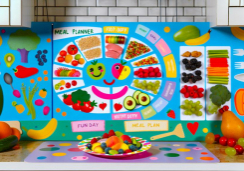Beginner's Guide to Low-Carb Meal Planning
You're considering your health, contemplating your diet, and committing to change—embarking on a low-carb journey is all about making informed choices that suit your lifestyle and goals.
As you wade through the sea of nutritional advice, you'll find that planning your meals can be the buoy that keeps you afloat in a tide of carb-heavy temptations. In this beginner's guide, you'll learn not only the foundations of what constitutes a well-rounded low-carb diet, but also the practical steps to crafting meals that are both satisfying and simple to prepare.
You'll discover how to navigate the grocery aisles for low-carb staples, how to handle social dining situations, and how to tweak your favorite recipes to fit your new dietary needs.
Stick with me, and soon you'll have the tools to construct a meal plan that energizes your body without tipping the scales on your carb count, leaving you well-equipped to forge a path towards a healthier you.
Understanding Low-Carb Diets
When embarking on a low-carb diet, you're reducing carbohydrate intake and increasing your consumption of protein and fats, a shift that has been supported by research to alleviate fears once associated with natural fats. Your low-carb meal plan may not necessarily induce ketosis like a strict keto diet, but both are grounded in the principle of limiting carbs per day.
Low carbohydrate diets often restrict grams of carbohydrates per meal, focusing instead on a variety of low carb foods that can help manage your diets on body weight and overall health. You'll eat on a low-carb regimen foods rich in nutrients, without having to fear natural fats, which are essential to your body's function. In fact, studies suggest that these fats aren't the enemy they were once thought to be, and you can safely include them in your diet.
Foods to Include and Avoid
To successfully navigate your low-carb meal plan, it's crucial to know which foods to stock up on and which to pass by. A balanced low carb diet focuses on whole foods, limits grams of carbs, and emphasizes nourishment.
When planning your meals, aim for a daily intake of carbohydrates that fits your goals, often ranging from 20 to 100 grams of carbs per day. Here's a handy list to guide your grocery shopping:
- Include:
- Lean proteins like meat and fish
- Non-starchy vegetables (think cauliflower rice instead of white rice)
- Eggs and healthy fats, including those high in saturated fatty acids
- Low-carb fruits such as berries in moderation
- Avoid:
- Sugary foods and beverages
- Starchy foods: bread, pasta, rice
- Legumes: beans, lentils
- High-carb fruits and processed snacks
Planning Your Low-Carb Week
Armed with knowledge of which foods to select and which to avoid, you're now ready to map out your low-carb week with confidence. To start, stock your kitchen with essentials like meat, fish, eggs, and above-ground vegetables that are low in carbs. You'll find that planning your low-carb week becomes simpler with these staples at hand.
Dive into low-carb meal plan resources for inspiration, such as keto pizza or keto pesto chicken casserole recipes. These meals are designed to keep your carbs per day within your target range while maximizing flavor and satiety. Remember, the goal of your low carb diet isn't just weight loss, but also to nourish your body with high-quality, nutrient-dense foods.
Stay vigilant about reading food labels to avoid hidden sugars and high-carb fillers that can sneak into your diet. Aim for meals composed of whole foods with grams of net carbs that align with your daily goals.
Don't forget to hydrate and include healthy fats like avocados and nuts in your diet. These fats are crucial for satiety and overall health. Additionally, pairing your diet with regular physical activity can enhance the benefits of eating low-carb, contributing to a well-rounded approach to wellness.
Low-Carb Cooking Tips
Mastering low-carb cooking starts with utilizing natural fats, such as those found in avocados and nuts, while consciously avoiding added sugars and starches.
When you're crafting a meal plan for your low carb diet, it's essential to include delicious low carb recipes that not only satiate but also provide enough nutrients without restricting calories too much.
Here are some cooking tips to help you stay on track:
- Plan Meals: Prepare your meals in advance to ensure you're not tempted to eat high-carb options.
- Read Labels: Always check food labels for hidden sugars and carbs that could disrupt your carbs per day limit.
- Hydrate: Drink plenty of water, as staying hydrated is crucial when you're consuming fewer carbs.
- Protein Intake: Make sure to include sufficient grams of protein in your meals and snacks to maintain muscle mass and satiety.
Managing Expectations and Challenges
When embarking on a low-carb journey, it's critical to set realistic expectations and prepare for the natural challenges that accompany dietary changes. A strict low-carb diet typically limits your carbs per day, which can lead to weight loss through appetite suppression and altered metabolism. However, managing expectations means recognizing that each person's response to low carbohydrate diets can vary.
Initially, you might face a low-carb challenge like fatigue or headaches, common side effects as your body transitions away from relying on carbohydrates for fuel. These symptoms are temporary, but they underscore the importance of a personalized meal plan that fits your lifestyle and nutritional needs.
Be patient and listen to your body. If you're finding the diet too restrictive or experience prolonged side effects, it's vital to adjust your meal plan accordingly. This doesn't mean you've failed; rather, it's a part of the process of finding what works best for you.
Frequently Asked Questions
How Do I Start a Low-Carb Diet for Beginners?
To start a low-carb diet, you'll need to learn carb counting, adjust macronutrient ratios, and consider meal timing. Choose snacks wisely, stay hydrated, be mindful of fat quality, and manage portion control.
What Can You Eat the First Week of a Low-Carb Diet?
You can enjoy eggs & avocado, cheese snacks, a variety of meats, seafood options, diverse veggie varieties, nut assortments, dress salads with olive oil, sip butter coffee, and indulge in Greek yogurt.
What Are 5 Foods to Avoid on Low-Carb Diet?
You should avoid bread, pasta, rice, potatoes, and sugary foods, which are high in carbs and can affect insulin resistance. Instead, focus on satiating fats, carb substitutes, and keto snacks for better results.
What Is the Number 1 Carb to Avoid?
You should avoid sugar, the top carb, due to its role in weight gain and health issues. Understanding refined sugars' danger and discovering hidden carbs is crucial in your low-carb journey.
Conclusion
You've navigated the low-carb landscape with ease, embracing foods that fuel your body while sidestepping excessive carbs. Remember, balance is key—don't skimp on vital nutrients.
As you prep and cook your weekly meals, stay flexible. Challenges will arise, but they're simply stepping stones to a healthier you. Keep experimenting with flavors and textures, and trust that with each low-carb meal, you're taking a stride towards your wellness goals.
Stay the course; your body will thank you.










